I’ve been no-tilling 45 years. That’s also my age. No-till is all I’ve ever known as my dad and grandfather were early adopters of the practice.
Harry Young — the original no-tiller — lived just an hour due northwest of our farm. Following his example, no-till double-crop soybeans were quickly adopted in our area with most using the original Allis Chalmers no-till planters. Dad and my grandfather were quick to adopt no-till soybeans, too, advancing to no-till corn soon after.
In the 1980s, the area extension and Miles Farm Supply started working on no-till wheat. They launched Opti-Crop consulting for intensive wheat management. We used that resource to get into no-till wheat, too. By the early 1990s, my predecessors had purchased a Great Plains no-till drill and had eliminated tillage from the operation apart from tobacco and watermelons.
We certainly took our lumps being early adopters of no-till. Things are much better today. Modern wheat is bred to better work in high residue no-till situations. Current varieties are less susceptible to disease, and there are more herbicide and fungicide options available. While it was a struggle early, today my no-till wheat will produce the same or better than wheat seeded into worked up ground.
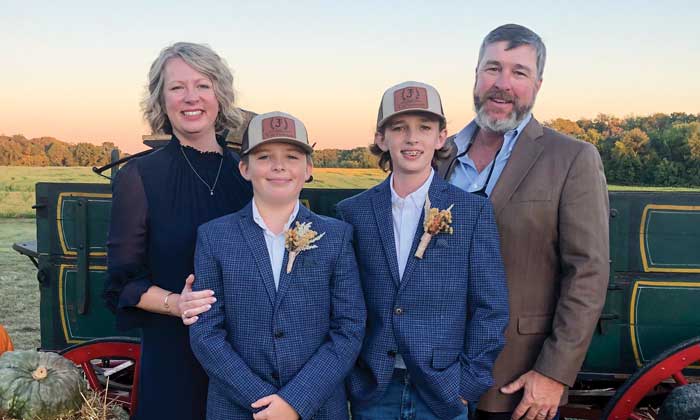
Brittany, Jack, Mac and Willis Jepson
Check The Specs...
NAME: Willis Jepson
LOCATION: Orlinda, Tenn.
ACRES: 7,000 acres (10,000 acres when counting double crop seeding)
YEARS NO-TILLING: 45
CROPS: corn, winter wheat, soybeans, dark tobacco, watermelons & pumpkins
PRIMARY SOIL TYPE: Pembroke
ANNUAL PRECIPITATION: 50 inches
IRRIGATION: 3 center pivots and drip irrigation in watermelons
Adding On
Instead of having to convince the old guard to do new things, I instead was pressuring myself to advance the farm. I needed to build our soils and make our farm more resilient in the face of variable weather, inputs and markets. Cover crops were my major contribution to the sustainable system that’s been building for generations.
In 2012, drought was taking a toll. My local soil conservation office got me to a cover crop meeting. Attending resulted in a lightbulb moment. They showed that if we kept the soil covered and kept living roots in it, the soil would be better able to buffer against challenges such as drought. Plus, even with no-till, we battle erosion as fields range from flat to quite steep “D” slopes. Adding more roots to the soil would help hold it in place better.
Tobacco’s been a good crop for us, but it’s hard on the soil. We’ve hung a tobacco crop in our barn pretty much every season since we started farming in 1806. Each crop was planted after using heavy tillage. Decades of intensive tillage degraded the soil, allowing it to erode and depleting soil organic matter (SOM). Before no-till, getting a 1% SOM on a soil test was considered high. Today we’re seeing 3, 4, even 5% on some of our long-term no-till and cover crop acres. Cover crops have been integrated wholly on our acres for about 8 years now.
NO-TILL TAKEAWAYS
- Cover crops increase water infiltration and keep more water available to crops for longer during drought conditions.
- Have a plan but be flexible when it comes to cover cropping and no-till.
- A stalk crusher on the corn head makes for smoother seeding of wheat and cover crops.
Winter wheat was already serving as a cover crop on half our acres. We just had to figure out how to get the other half covered. CSP and EQIP programs allowed for low-risk experimentation. Now we also have University of Tennessee and NRCS trials on our ground helping prove what species and practices work best.
My disclaimer for all the following cover crop advice is what works for me, may not work anywhere else. You must be committed to figuring out the puzzle unique to your own farm. Don’t give up. Keep learning and keep picking at it until you make it work.
Our first struggle was establishment. Cover crops needed to follow double-crop soybeans in a corn, wheat, double-crop soybean, then corn rotation. Double cropped soybeans aren’t harvested until late October or early November.
We tried aerial seeding and using a fertilizer truck to spread seed prior to leaf drop. This works fine in the cases of full-season soybeans or going into standing corn, but not so much for no-till double-crop soybeans.
We’d get a good stand of cover crops, harvest the soybeans, come back a week later and the cover crop was gone. We figured the seed was struggling to work its way through straw from a 90 to 100-bushel wheat crop. Many of the seeds were germinating in the straw and not rooting deeply into the soil. When we clipped and pushed across them at harvest, they dried out and died due to the stress.
Coverage was often spotty. It made it difficult to manage fertility when there were areas of heavy biomass right next to areas with none. It also made managing planter settings a struggle. We needed an even stand.
Despite a late harvest, we decided to drill cover crops. Warm-season species were dropped from the mix, and we added more winter-hardy options. Seeding clover in November didn’t result in much nodulation prior to corn planting the next spring, but we found Austrian winter peas were able to achieve better nodulation in less time.
Though better at producing nitrogen (N) quickly, peas can create a problem for planting green, which we do. Martin-Till Razor Tooth row cleaners (Martin is just down the road from us, too) work nicely to slice through the viny residue at planting. Great Plains Spider closing wheels bring up the rear as we feel they work better for closing in high residue situations.
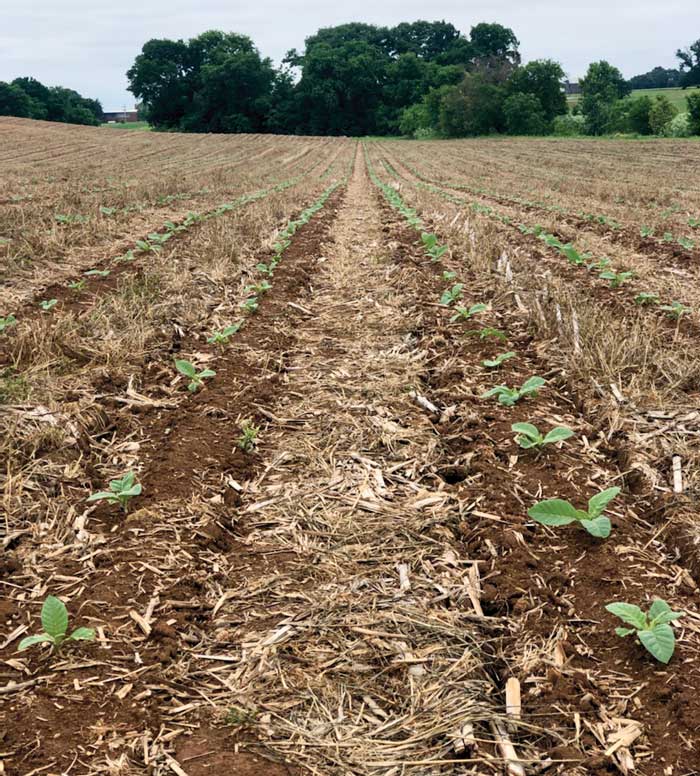
REDUCING MORE. Switching to strip-till for tobacco reduced soil disturbance and improved wheat yields following tobacco crops. On-farm trials still show a yield drag with no-till tobacco, but the goal is to eventually work out the puzzle and do away with more tillage.
From equipment to species to seeding strategy, cover crops have a lot of puzzle pieces to fit together. What I’ve found is you can’t just start with a plan for one piece of the cover crop puzzle. You need a strategy for each piece and the ability to call an in-season audible when a piece doesn’t fit the way you thought it would.
We’re on our 4th year of drilling cover crops late. The late mix generally includes winter peas, barley, oats and some clover — though we never seem to do the same thing twice. We bump up the seeding rate a bit the later the seeding gets. We’ve been able to drill cover crops into December. It’s not uncommon to hit 75 degrees Farenheit at Christmas here.
Right Tools
Increasing yields and the use of cover crops have taught us sometimes you need to swap out tools that worked in the past to get the current job done right. One area I’ve made changes is residue management options with our combines.
Starting in 2021, we run a Yetter Stalk Devastator under our 16-row corn head. It rolls stalks down, splits them open and chops them up a bit. I like that it prevents damage to tires, especially since we come in immediately after to no-till winter wheat.
After a big corn crop, those stalks are still juicy and green. It proved difficult to get through that tough, fresh residue with the drill to sow wheat. The Devastator rollers lay everything down so the drill can glide through easily. Row units bounce less, which gets us a more consistent seeding depth.
“We do the best we can in the system we have, even if that means compromising…”
For wheat harvest, I keep chopper hammers sharp to chew up the wheat straw more. A power tailboard spreader ensures residue is spread evenly.
Two 40-foot John Deere N540 air drills serve to seed wheat and cover crops. They’re run pretty much stock. We run a 16-row, 30-inch John Deere 1795 planter that we can split to a 32-row, 15-inch spacing for planting soybeans. The planter is equipped with Martin Razor Tooth row cleaners and Great Plains Spider closing wheels.
Originally, we ran a Martin spike closing wheel with a cast wheel but moved to the Spider wheel as it seemed to hairpin less in our high residue system.
Anhydrous is applied in the spring using spring-loaded Hiniker closing wheels behind the shank. Anytime I make a pass, I want to minimize disturbance as much as possible. The closing wheels push the soil back together and seal in the anhydrous. After applying anhydrous, it just looks like I’ve no-tilled the fields.
I do get some pushback that using anhydrous ruins any strides I’m making with cover crops and soil health. I have no doubt split applications of N and sidedressing is the way to go, but we need our manpower focused on specialty crops and wheat in spring and early summer. We do the best we can with the resources we have and the system we use even if that means compromising. I still see a ton of earthworms in my fields, though, and SOM is building.
Taming Tobacco
Tillage for tobacco went on much longer than it should have. We could still do better, but we have at least shifted to strip-tilling tobacco. Ideally, we’d like to no-till tobacco, but there’s still a yield drag. It’s a high-input, intensively managed crop. There isn’t a lot of room to mess up.
Shifting to strip-till reduced the tillage pass and provided some surprising results in wheat. Our worst wheat crop was always on acres following tobacco. We thought it was herbicide carryover. When we started strip-tilling tobacco, however, suddenly our very best wheat crop was the one following tobacco.
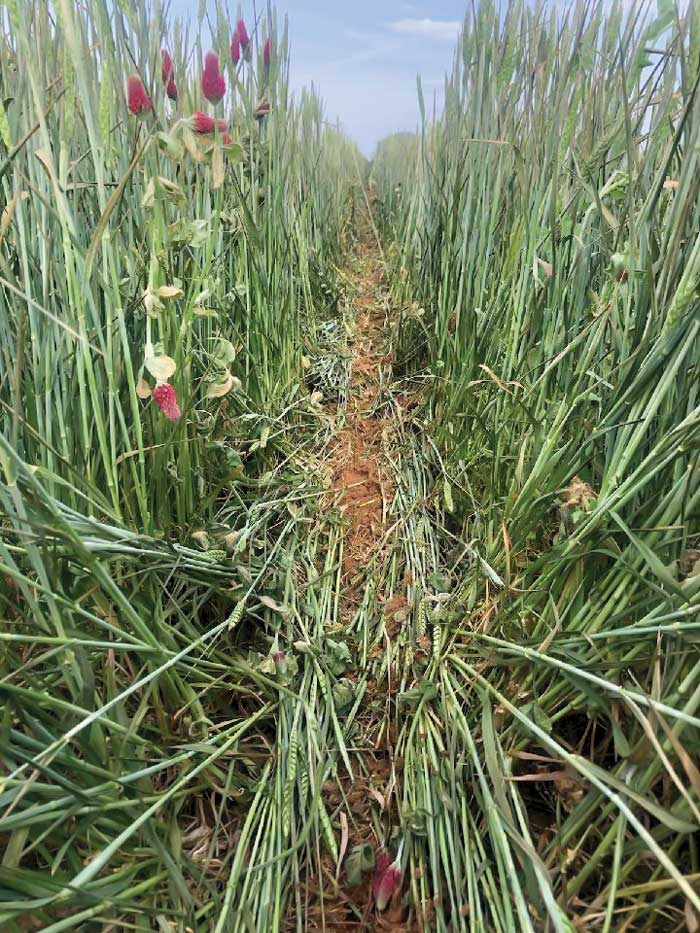
GOING GREEN. Jepson plants cover crops on almost every acre every year. Late-drilled cover crops include Austrian winter peas, barley, oats and red clover. Sharp Martin-Till Razor Tooth row cleaners help cut through the still-growing residue to seed corn in spring.
It wasn’t the herbicides the wheat didn’t like; it was the intensive early spring tillage that created compaction zones and destroyed soil structure. We raise 200 acres of dark tobacco. It still hurts me to drive by and see some of our best ground strip tilled, but it’s too big of a profit center for us to cut out. I compromise by following tobacco with as many years of no-till and cover crops as possible after. The soil recovers well, so I’m happy with that decision.
Some people are very rigid about never tilling, but I think there’s a place for everything. We have a deep no-till ripper, a roller and even a chisel plow still on the farm. We use a disc to level things up when there’s a rut or we get a little ditch eroding in our steep fields. Farming is messy, and sometimes we must address a problem. That’s just life. No system
is bulletproof.
Proving Up
Cover crops have anecdotally proven their worth on the farm, but I want to quantify the financial benefit. You can’t spend $50 an acre and not be somewhat certain of a return. That’s part of what we’re looking at in the cover crop plots we have on the farm.
They seemed to pay this year. In summer 2022, we didn’t get any rain from May through mid-July and had a month of temperatures hitting 90-105 degrees Farenheit daily. Soil temperatures and soil moisture in the cover crop plots versus the test plots were amazing. Soils in the cover crops were 12 degrees cooler than in the plots with no cover crops. Cooler soils and extra soil moisture available during corn pollination made a 25 bushel-per-acre difference, according to in-season forecasts.
I could see the difference in corn where we had cover crops and where we didn’t, like on newly rented ground. It was hot and dry for so long, yields were severely diminished anyway. However, our corn held on two weeks longer than corn that didn’t have cover crops and improved SOM. If it would have caught a rain during those 2 weeks, it would have made a huge difference in yield.
Nathan Hicklin, USDA-NRCS acting state agronomist, has had plots out for the last 4 years — 5 after harvest 2022. He says the plots have really showed the benefits of cover crops during drought, likely due to the changes in water infiltration and soil health.
There are three comparisons: five cover crop species, three species and no cover crop. In 2019, all three treatments had water infiltration rates ranging from 1 inch per hour to 1.4 inches per hour. In 2021, the no cover crop control infiltrated 1.1 inches of water per hour, while the five species mix plot infiltrated 3.5 inches of water per hour.
Soil testing shows our SOM is increasing. We’re using the Haney test to try to get an idea of our available nutrients. The test shows overall increases in soil health scores, but microbial diversity has been slower to improve than water infiltration. Nathan says we’re seeing a more balanced microbial community after 4 years of cover crops.
The anecdotal economic data shows cover crops providing an immediate financial benefit when moisture is a limiting factor.
In 2018 and 2019, there was adequate rainfall. In 2019, the five species cover crop plot saw just over a 6 bushel per acre yield advantage but yielded about $21 per acre more revenue due to more yield and one less herbicide pass. In 2020 there was adequate rainfall for the soybean crop. At harvest, there was a 3-bushel advantage with the five-species cover crop, but a roughly $27 loss in adjusted revenue per acre. However, the soybean crop yielded nearly the same with the three-species cover crop, but the three-species cover crop provided an additional $14 in revenue. The adjusted revenue includes cover crop seed and cost of planting.
Significant advantages were seen in 2021 when only ½-inch of rain fell during pollination. Corn yielded nearly 18 more bushels in the five-species cover crop plot and 21.6 more bushels in the three-species cover plot over the no cover crop control. The adjusted revenue was an astounding $68 per acre more with the five-species cover and an amazing $94 per acre advantage with the three-species cover.
There seems to be a clear advantage to having cover crops in drought. It is also interesting that the three-species cover crop may be a better fit than the more robust mix.
We feel good about our system. It’s protecting the soil with biomass, building SOM, retaining more moisture, keeping the soil cooler and giving us a yield bump. We’re not cutting back commercial fertilizers just yet. We think there’s a lot more nutrients cycling in our system now. That’s going to be key for profitability in the future as crop inputs keep going up.
After my wife Brittany and I, our sons, Mac (15) and Jack (11), will be the 8th generation to farm this ground. They’re being raised as no-tillers and cover croppers. They love digging around in the fields for worms and insects. They’re certainly interested, and it will be interesting to see where they take us in the future.

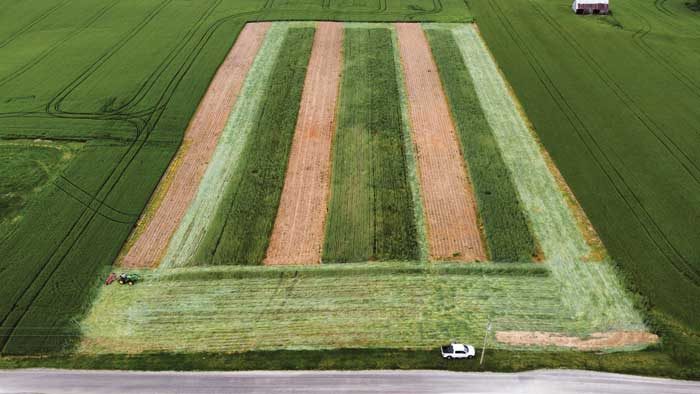


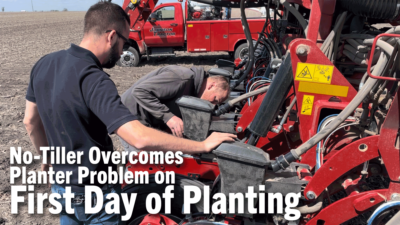



Post a comment
Report Abusive Comment